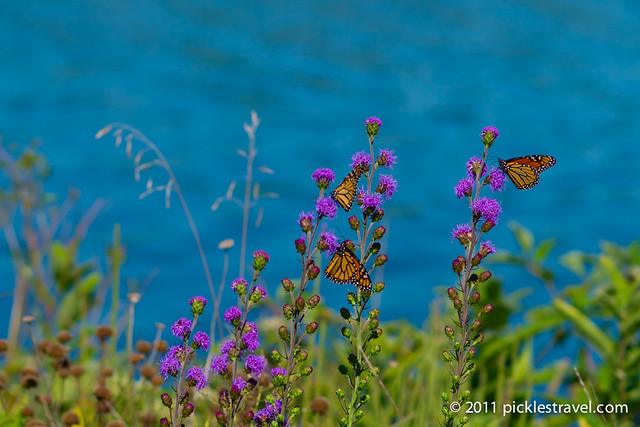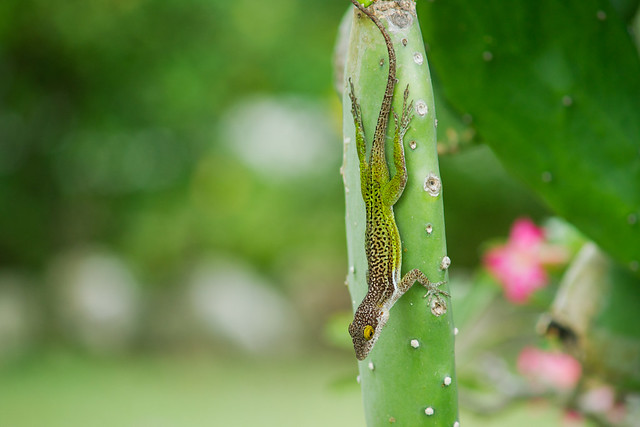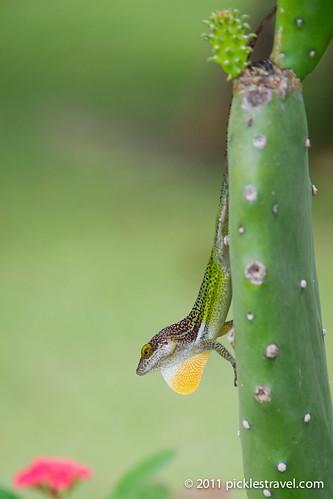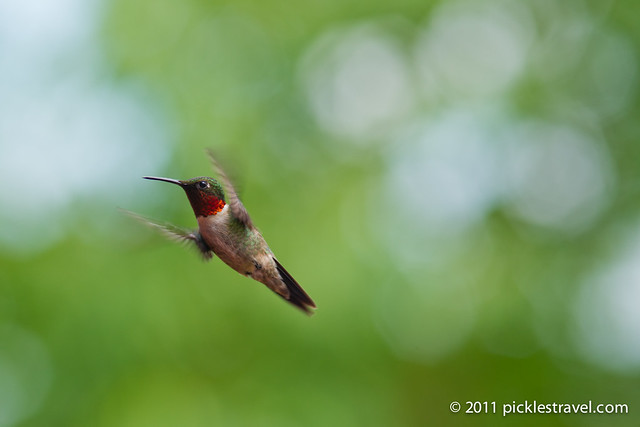 ISO 100, 100mm, f/3.5, 1/2000 sec. Monarchs on Lake Phalen, St. Paul, Minnesota
ISO 100, 100mm, f/3.5, 1/2000 sec. Monarchs on Lake Phalen, St. Paul, Minnesota
Patience is key
Any kind of wildlife or nature photography requires a huge amount of patience. You have to wait for the light to be right, or for the animal to do something interesting.
 ISO 320, 210mm, f/6.3, 1/125 sec. A rather un-interesting picture of a lizard in Antigua
ISO 320, 210mm, f/6.3, 1/125 sec. A rather un-interesting picture of a lizard in Antigua
It’s the action of the animal that makes it intriguing. I always consider that to mean anything that is natural to them, but difficult to capture with a camera and/or rarely seen (flight, capturing dinner, spending time with young, etc.)
 ISO 320, 210mm, f/8 1/200 sec The lizard becomes more interesting by showing his dewlap (now if he had only been eating too…)
ISO 320, 210mm, f/8 1/200 sec The lizard becomes more interesting by showing his dewlap (now if he had only been eating too…)
This lizard was blending in nicely to it’s environment, which I found intriguing and as I sat there and watched him he decided to show his true colors – I believe it’s called a dewlap. He was probably sensing my presence and not too happy about it, but it made for a very happy photographer – me.
Difficulties with Wildlife Photography
 ISO 200, 300mm, f/7.1, 1/800 sec. American Bald Eagle
ISO 200, 300mm, f/7.1, 1/800 sec. American Bald Eagle
One of the tough things about photographing animals in their natural environment is that they tend to be hidden, from us, their prey and any possible predator they may have. I post the photo above to show what my typical bald eagle picture looks like- full of distractions. To get a good image you have to work around the distractions- either by anticipating the wildlife’s next move, or by integrating them into the photo.
Wildlife in Motion
 ISO 160, 200mm, f/4.3, 1/400 sec. Ruby-Throated Hummingbird in Minnesota
ISO 160, 200mm, f/4.3, 1/400 sec. Ruby-Throated Hummingbird in Minnesota
I captured this guy at 1/400 sec shutter speed, which is a pretty slow shutter, considering how quickly these guys move. He must have been hovering. Though there is barely a hint of his wings at that speed (At 55 beats per second it would be pretty much impossible to capture the wings not in motion!) Usually I would have my shutter speed cranked up to 1/1000 or higher for these fast moving guys (which means higher ISO).
When I take photos of hummingbirds I do like to keep my aperture a bit smaller and use manual focus- as they flit in and out of the camera frame so quickly that it’s hard to get a good fix on them otherwise.
Macro
 ISO 320, 100mm, f/6.3, 1/1000 sec. Natural light scorpion (?) in St. Mary’s, Georgia
ISO 320, 100mm, f/6.3, 1/1000 sec. Natural light scorpion (?) in St. Mary’s, Georgia
I post this image to show a difficulty I have with macro photography. The complications with macro photography is that if you don’t have either an incredibly bright sun/light or a flash of some sort, it’s hard to get every part of the insect/spider/animal in focus (unless you stand further away…)
This mini scorpion photo was taken with natural light and I think an ISO higher than 320 would have rendered him blurry with noise. The problem I find is that the front of him is in focus, but the back is not. He was moving too fast to really want to lower the shutter speed any, and obviously I needed a wider aperture, so… apparently I need a flash. I know some macro photographers will take multiple images with the focus changing as they go and then combine to create one awesome shot, but I would love to know if there’s a better way.
Pingback: Goals for Photographing 2012